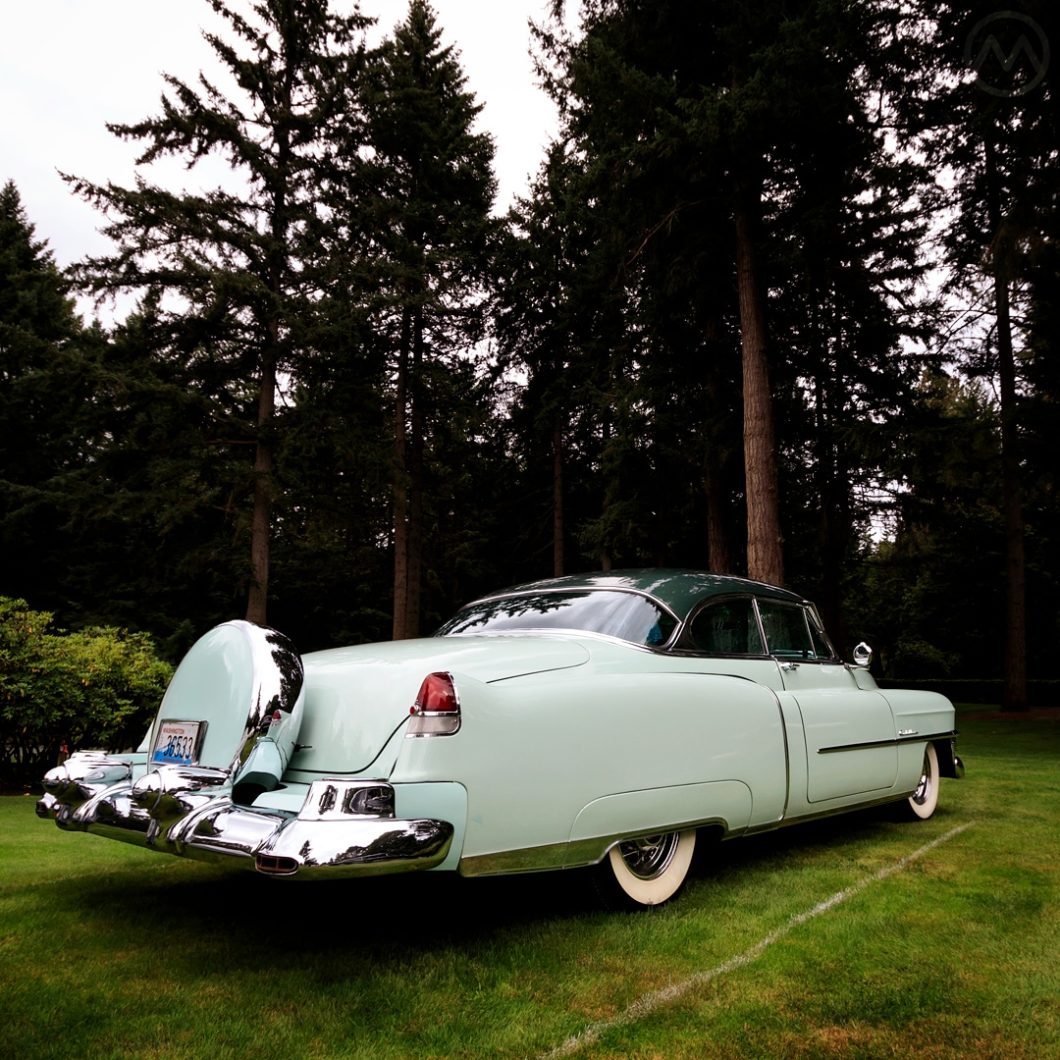If you wanted to say you’d “arrived” in 1953, there were few better ways to get that point across than a Coupe de Ville. In the immediate postwar years Cadillac solidified its dominant position as America’s top luxury car maker, and culturally they were a symbol of success beyond their measure as automobiles – Sugar Ray Robinson’s pink 1950 Cadillac as almost as famous in Paris as he was.
After the introduction of the first postwar Cadillacs in 1948 with their subtle, Lockheed P-38 fins and the new OHV V8 in 1949, the 1950-53 models changed only slowly but were arguably ever more flamboyant – bigger bumpers, more trim, more chrome, brighter colors. On top of that, nothing said flamboyance like the ultimate 1950s aftermarket accessory – a huge Continental kit.
Fantastic Fins
The most prominent piece of style on these postwar Cadillacs was undoubtedly the tailfins – which evolved out of a visit Harley Earl arranged for stylists Art Ross, Bill Mitchell, and Frank Hershey to see an early P-38 airplane in 1941 at Selfridge field (today Selfridge Air National Guard Base) northeast of Detroit. The twin-boom fuselage immediately enthralled the team, but work on actual production cars influenced by it wouldn’t happen until late in the war thanks to various team members’ military service.
The group that adapted the fins for production was a who’s who of GM all-stars including Hershey and Mitchell (both on that first trip), and Ned Nickles. Though Earl didn’t like them at first, chairman of the board Alfred Sloan did, as did Charlie Wilson, Sloan’s successor as President and future Secretary of Defense.
Similarly, in the 1945-46 period when they were being developed, Cadillac’s general managers both fretted about the fins. Both, because this was a time of transition when long-serving and successful Nicholas Dreystadt was handing off the management baton to the incoming Jack Gordon. Both were on the fence about the fins – which seemed too radical.
They needn’t have worried. The fins had the effect of enhancing Cadillac’s image as a technology-minded company even if they were pure decoration. They were hugely popular and Packard had nothing to compete with them. Lincoln and Chrysler’s Imperial were, in those days, distant objects in Cadillac’s rear view mirror.
1949 brought Cadillac’s modern OHV V8, which gave the cars almost unprecedented speed. It’s performance would have blown away any of the Cadillac’s prewar engines, V-16s included, and the Cadillac V8 quickly became a favorite of racers and hot rodders. Not even a year later the Cadillac engine was powering cars like the Allard K2.
The Coupe de Ville
That year Cadillac also added a proper 2-door hardtop to the line – the first Coupe de Ville – that quickly supplanted the 1948-49 fastback coupes. Nickles was responsible for the hardtop design, which was refined into ever lower-looking treatments in 1950-53.
Although convertibles like Robinsons’ car were the flashiest and most desired models, the Coupe de Ville offered the hardtop look of a top-up convertible with the practicality of a closed car. The hardtop roof was also offered on the other C-body cars – the Buick Roadmaster Riviera and Oldsmobile 98 Holiday. These were the first proper volume production hardtop cars and were quickly emulated by the rest of the industry. The Coupe de Ville was, of course, the cream of the crop.
Underneath power came from the ever more powerful 331-cid Cadillac V8, after 1950 mated only to automatics. The Hydramatic had become so popular by 1949-50 that there was no reason to offer a manual transmission anymore, and manuals would not return to Cadillacs for decades.
A fire at the Hydramatic factory in August of 1953 set back supplies so much that a few ‘53 Caddies were equipped by Buick Dynaflows – not quite as nice as the updated Hydramatics – but few if any customers complained.
Who could complain when you’d “made it?” In an era when what you drove really mattered to other people and Cadillac conveyed almost Rolls-Royce prestige, nobody cared if it was a Dynaflow or a Hydramatic, though it did make for awkward servicing later.
By 1952, Cadillac styling was run by Ed Glowacke – a consummate professional who ate, slept, and breathed Cadillac and might have succeeded Harley Earl if not for health problems that eventually claimed his life in 1962. Under Glowacke a new and soon-to-be all-star staffer, Dave Holls got his start doing detail work starting on the ‘53s (like this car).
Continental Kits
The Continental kit trend, though spare tires had been mounted that way for decades, emerged after E.T. “Bob” Gregorie’s 1940 Lincoln Continental styled the look so well.
Envelope bodies made sidemount spares a thing of the past, and full-size spares took up a huge amount of trunk space, so the “Continental Kit” was one way to alleviate this space issue and give the car some outward visual style.
The nascent automotive aftermarket offered hundreds of such kits for different models, and before long some were factory supplied. In the chrome-laden 1950s the Continental kit was the ultimate aftermarket accessory, even when they did not actually house a real tire, which was sometimes the case.
The trend faded in the early 1960s, but nothing said “Detroit dreamboat” louder. Nor were continental kits confined to the fifties – although that was their peak era. The kits are still available today and were sometimes seen on full-size new luxury cars into the 1980s.
The Coupe de Ville was a hugely popular and commanding presence in 1953 although it was one-upped that year by a new product – the limited production Eldorado. That car, a convertible only, presaged the 1954 redesign of the whole Cadillac line waiting in the wings – a line styled under Glowacke’s capable direction.

